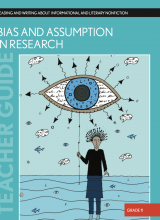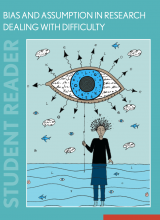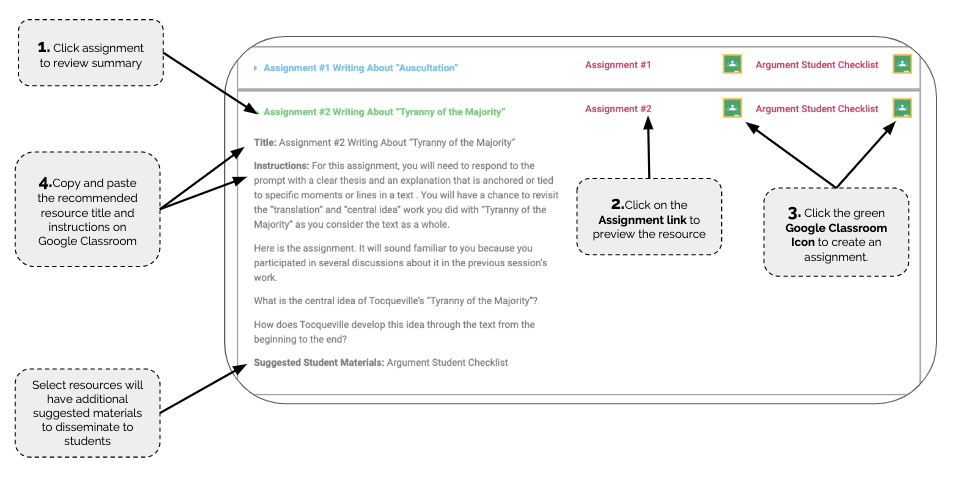Bias and Assumption in Research - Grade 11
When one is consulting research to make a decision or take action, it’s important to understand some ways to evaluate its quality and accuracy. This unit sheds light on how to view research through a more thoughtful, critical lens instead of just merely accepting research findings at face value and to see reports on research as arguments people make based on evidence rather than as extra-human statements of pure truth.


Table of Contents
Writing Tasks
Title: “The Order of Things: What College Rankings Really Tell Us” Unfamiliar Terms and Confusing Moments
Teacher Manual Instructions:
Session 1
Give students a moment to individually skim back through the text, examine words and moments they marked during the first read, and mark any additional parts that stand out to them as being confusing or difficult.
Then, ask students to return to their small groups. As they work, students should share their initial markings with each other and review other portions of the text for additional ideas. Encourage students to use each other as a resource for simple questions and to build a list that contains the most significant or challenging difficulties they’ve identified. Give the groups 5-7 minutes to work on the first two columns of their chart.
Title: Assignment #1 Explaining Gladwell’s Ideas
Teacher Manual Instructions:
Session 3
In “The Order of Things: What College Rankings Really Tell Us,” Malcolm Gladwell explains the problems inherent in a comprehensive and heterogeneous ranking system. Since the subject matter is fairly complex, one of the best ways to clarify these ideas is to write about them. Writing has the unique capacity to help make your thinking more precise.
For this assignment, you will write a 1- to 2-page paper that explains Gladwell’s key ideas in his essay “The Order of Things: What College Rankings Really Tell Us.” Here is your task:
Using what you’ve learned from Gladwell’s article, explain the problems associated with a ranking that is both comprehensive and heterogeneous to someone who doesn’t know much about the subject. |
Suggested Student Materials: Informational_Explanatory Checklist
Title: “Women’s Brains” Unfamiliar Terms and Confusing Moments
Teacher Manual Instructions:
Session 4
Give students a moment to individually skim back through the text, examine words and moments they marked during the first read, and mark any additional parts that stand out to them as being confusing or difficult.
Then, ask students to return to their small groups. As they work, students should share their initial markings with each other and review other portions of the text for additional ideas. Encourage students to use each other as a resource for simple questions and to build a list that contains the most significant or challenging difficulties they’ve identified. Give the groups 7-8 minutes to work on the first two columns of their chart.
Title: Assignment #2 Analyzing Gould’s Arguments
Teacher Manual Instructions:
Session 6
Paying close attention to how expert writers develop arguments can provide insight into how you can strengthen and improve how you make your own arguments.
For this assignment, you will analyze how Gould develops his argument in his essay “Women’s Brains” by writing a one- to two-page paper in response to the following questions:
|
Suggested Student Materials: Informational_Explanatory Checklist
Title: Assignment #3 Synthesizing Ideas: Gladwell and Gould
Teacher Manual Instructions:
Session 7
During the previous sessions, you worked hard to read, comprehend, and analyze two separate texts on the topic of bias and assumption in research. For this assignment, you will now have an opportunity to synthesize information from across these two texts.
Here’s the assignment:
In your life after high school, you will regularly encounter research reports and arguments on important issues in which people reference the find- ings put forth in research reports. Drawing on what you learned from both articles, write a one- to two-page letter to your future self in which you offer clear and specific advice about what you should be mindful of when weighing and considering research findings in your post high school years. Your letter should reference the big ideas, arguments, and specific moments in both the Gladwell and Gould texts. |
Charts for Discussion
Title: What We Learned From Reading “The Order of Things: What College Rankings Really Tell Us”
Teacher Manual Instructions:
Session 1
Facilitate a short whole-group share where the class collaborates to create a master list of this information. To create this master list, call on students to share what they learned from reading this text. Students should point to places in the text to support their responses. Capture student responses on a chart titled “What We Learned From Reading ‘The Order of Things: What College Rankings Really Tell Us.’” Tell students since this is only their first read, and because they will be given multiple opportunities to reread this text, the intent is just to capture the gist of what they learned. It’s important to note that the pace of this “what we learned” activity is brisk and not at all comprehensive. This is a working chart that will be added to in the upcoming sessions.
Title: What We Learned From Reading “Women’s Brains”
Teacher Manual Instructions:
Session 4
Facilitate a short whole-group share where the class collaborates to create a master list of this information. To create this master list, call on students to share what they learned from reading this text. Students should point to places in the text to support their responses. Capture student responses on a chart titled “What We Learned From Reading ‘Women’s Brains.’” Tell students since this is only their first read, and because they will be given multiple opportunities to reread this text, the intent is just to capture the gist of what they learned. It’s important to note that the pace of this “what we learned” activity is brisk and not at all comprehensive. This is a working chart that will be added to in the upcoming sessions. Allow students a few extra minutes to record any additional insights from the master list into their own notebook.
Checks for Understanding
Title: “The Order of Things: What College Rankings Really Tell Us” Unfamiliar Terms and Confusing Moments
Teacher Manual Instructions:
Session 1
Reconvene the class and facilitate a whole-group share where the class collaborates to create the first two columns of the whole-class version of “‘The Order of Things: What College Rankings Really Tell Us’: Unfamiliar Terms and Confusing Moments” chart.
To create this master chart, call on students to share the unfamiliar terms and confusing moments from their group list. Capture these in column one of the class chart. Be sure to include line numbers for each term or moment in the first column.
As students share their terms and moments, be sure to identify why the moment is difficult, especially if it is more than a simple question of vocabulary. Did the writer make a confusing comparison? Did he refer to an idea that you aren’t familiar with? Record these explanations in column two.
Tell students that the list of difficult moments they’ve created in their notebook might differ slightly from the master list they’ve created together as a class. Encourage students to record additional entries in their notebooks that they might have missed when they were working in their small groups. Let students know it is not necessary for them to record these additional entries in their notebook if they do not find the terms or moments offered by their peers to be difficult, confusing, or unclear.
Title: What We Learned About Identifying and Resolving Unfamiliar Terms or Difficult Moments
Teacher Manual Instructions:
Session 1
After the class has built a list of strategies for resolving difficulties, return to the list of moments from the text. Item by item, confirm that your list of strategies will provide a solution. If you come across a difficulty that does not yet have a possible solution, brainstorm ideas and add them to the list of strategies.
Finally, have students turn and talk to a partner about what they learned about the process of identifying unfamiliar terms or confusing moments. Ask a few students to share. Be sure to capture responses on a new chart titled “What We Learned About Identifying and Resolving Unfamiliar Terms or Difficult Moments.”
Title: “Women’s Brains” Unfamiliar Terms and Confusing Moments
Teacher Manual Instructions:
Session 4
Reconvene the class and facilitate a whole-group share where the class collaborates to create the first two columns of the class chart titled “‘Women’s Brains’: Unfamiliar Terms and Confusing Moments.”
To create this master chart, call on students to share the unfamiliar terms and confusing moments from their group list. Capture these in column one of the class chart. Be sure to include line numbers for each term or moment in the first column.
As students share their terms and moments, be sure to identify why the moment is difficult, especially if it is more than a simple question of vocabulary. Did the writer make a confusing comparison? Did he refer to an idea that you aren’t familiar with? Record these explanations in column two.
Tell students that the list of difficult moments they’ve created in their notebook might differ slightly from the master list they’ve created together as a class. Encourage students to record additional entries in their notebooks that they might have missed when they were working in their small groups. Let students know it is not necessary for them to record these additional entries in their notebook if they do not find the terms or moments offered by their peers to be difficult, confusing, or unclear.
Independent Reading
Title: Book Interview
Instructions:
Display a copy of the “Book Interview” sheet for the class to see and distribute copies to students.
Using one of the books from the classroom library, model for students how to interview a book and how to fill out the sheet. Answer any questions students have about the form and its terminology.
Give students time to interview three books and to enter their findings on the “Book Interview” sheet.
Title: Book Pass
Instructions:
Organize students’ desks into a circle (or, if this is not possible, determine a very clear path for books to pass through the group).
Explain the purpose of a book pass:
A book pass is another way to expose students to the texts available in the classroom library. A book pass requires students to use their book interviewing skills. A book pass is a chance for students to find titles to add to their “Books I’d Like to Read” list.
Display a copy of the “Book Pass” for the class to see and pass out copies to students.
Demonstrate for the class how a person goes about making an entry on the form. Since students will need to write quickly, show how an author can be listed just by last name and first initial, and demonstrate how a student can abbreviate a long title if necessary. What matters is that they have enough information to track down the book again later if they need to.
Give each student one book (or magazine). Tell them it doesn’t matter which text they start with, because they will see all—or at least many of—the books. (Be sure you have one title for each student in the circle.)
Choose a direction for passing.
After students receive a book, they should immediately record the author’s name (if the text is a book) and title on the “Book Pass” form.
Give students one minute to interview each book following the procedure established in the previous session.
At the end of one minute, call “pass.” At this time, students should make an entry in the comments column and pass the book to the next student.
Continue the book pass until each student has interviewed all the books.
Title: Book Recommendation
Instructions:
Distribute copies of the “Book Recommendation” form to students and give them time to craft or begin crafting their first review. Students can choose to write about a book they’ve completed recently or one they remember well from past reading.
Title: Goals for My Reading Life
Instructions:
Display a copy of “Goals for My Reading Life” for the class to see and distribute copies to students.
Use this time to review how to fill out the goals sheet. Be sure to show students how they can use the charts to generate ideas for answers to the “Goals” questions.
Take a moment to stress the value and function of the “Books I’d Like to Read” list. Point out that this list is a tool that serves the same function as a bedside table for some readers: It is a place to store up titles or books that are “next in line.” Remind the class that readers constantly have their eyes open for “next” texts. A “Books I’d Like to Read List” is a way to prevent aimless and unproductive castings around for new reading materials. It’s a planning tool.
Explain that at the beginning of each marking period, each student will fill out a new goals sheet; at at the end of each marking period, students will take a few minutes to review their goals statements and reflect on their efforts to meet them.
Answer any questions students have about the “Goals for My Reading Life” forms.
Give students time to complete the form and set a deadline for submission. You may decide to photocopy these to keep a set for yourself. Return the forms to students during the next session and have them attach the form to a page in their notebook or save it for their student portfolio (see Creating a Student Portfolio).
Title: Reading Log
Teacher Manual Instructions:
Show students how to set up a “Reading Log” in their notebook. They should be sure to enter it in their table of contents. You may decide to distribute sticky notes so that students can flag this page. Use the model on the next page to guide your efforts.
Notice the column titled “Date Completed/# of Pages Read.” This column is a place for students to record, and receive credit for, the reading of texts that did not require a “cover-to-cover” experience. Be sure to point out that reading sections of several texts for specific purposes is not the same as skipping aimlessly from book to book to book. The former often indicates purposefulness and interest; the latter can indicate confusion or disengagement.
After students have set up the reading log—including proper headings, creating the grid, etc.—demonstrate how to make an entry.
Answer any questions students have about the log.
Remind students that the reading log is a tool to be used in conjunction with the “Goals” sheets. Students track their reading in the log and then use the log to evaluate their progress toward their goals.
If you plan to use student portfolios this year, consider introducing them at this time using some version of the information in the section that follows. Review Creating a Student Portfolio in advance to be sure you have thought through some of the important questions for portfolio work.
Unit Resources
Title: Assignment #3: Synthesizing Ideas: Gladwell and Gould
Title: Grades 11 and 12 – Informational_Explanatory Rubric
Title: Scaffolds and Modifications: Descriptions and Use
